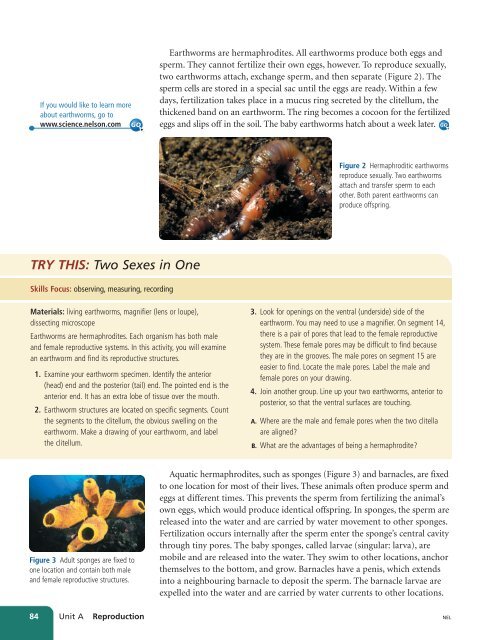Unit A Reproduction
Unit A Reproduction
Unit A Reproduction
You also want an ePaper? Increase the reach of your titles
YUMPU automatically turns print PDFs into web optimized ePapers that Google loves.
If you would like to learn more<br />
about earthworms, go to<br />
www.science.nelson.com GO<br />
Earthworms are hermaphrodites. All earthworms produce both eggs and<br />
sperm. They cannot fertilize their own eggs, however. To reproduce sexually,<br />
two earthworms attach, exchange sperm, and then separate (Figure 2). The<br />
sperm cells are stored in a special sac until the eggs are ready. Within a few<br />
days, fertilization takes place in a mucus ring secreted by the clitellum, the<br />
thickened band on an earthworm. The ring becomes a cocoon for the fertilized<br />
eggs and slips off in the soil. The baby earthworms hatch about a week later. GO<br />
Figure 2 Hermaphroditic earthworms<br />
reproduce sexually. Two earthworms<br />
attach and transfer sperm to each<br />
other. Both parent earthworms can<br />
produce offspring.<br />
TRY THIS: Two Sexes in One<br />
Skills Focus: observing, measuring, recording<br />
Materials: living earthworms, magnifier (lens or loupe),<br />
dissecting microscope<br />
Earthworms are hermaphrodites. Each organism has both male<br />
and female reproductive systems. In this activity, you will examine<br />
an earthworm and find its reproductive structures.<br />
1. Examine your earthworm specimen. Identify the anterior<br />
(head) end and the posterior (tail) end. The pointed end is the<br />
anterior end. It has an extra lobe of tissue over the mouth.<br />
2. Earthworm structures are located on specific segments. Count<br />
the segments to the clitellum, the obvious swelling on the<br />
earthworm. Make a drawing of your earthworm, and label<br />
the clitellum.<br />
3. Look for openings on the ventral (underside) side of the<br />
earthworm. You may need to use a magnifier. On segment 14,<br />
there is a pair of pores that lead to the female reproductive<br />
system. These female pores may be difficult to find because<br />
they are in the grooves. The male pores on segment 15 are<br />
easier to find. Locate the male pores. Label the male and<br />
female pores on your drawing.<br />
4. Join another group. Line up your two earthworms, anterior to<br />
posterior, so that the ventral surfaces are touching.<br />
A. Where are the male and female pores when the two clitella<br />
are aligned?<br />
B. What are the advantages of being a hermaphrodite?<br />
Figure 3 Adult sponges are fixed to<br />
one location and contain both male<br />
and female reproductive structures.<br />
Aquatic hermaphrodites, such as sponges (Figure 3) and barnacles, are fixed<br />
to one location for most of their lives. These animals often produce sperm and<br />
eggs at different times. This prevents the sperm from fertilizing the animal’s<br />
own eggs, which would produce identical offspring. In sponges, the sperm are<br />
released into the water and are carried by water movement to other sponges.<br />
Fertilization occurs internally after the sperm enter the sponge’s central cavity<br />
through tiny pores. The baby sponges, called larvae (singular: larva), are<br />
mobile and are released into the water. They swim to other locations, anchor<br />
themselves to the bottom, and grow. Barnacles have a penis, which extends<br />
into a neighbouring barnacle to deposit the sperm. The barnacle larvae are<br />
expelled into the water and are carried by water currents to other locations.<br />
84 <strong>Unit</strong> A <strong>Reproduction</strong><br />
NEL

















